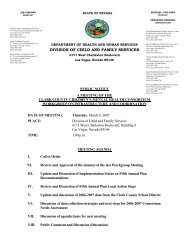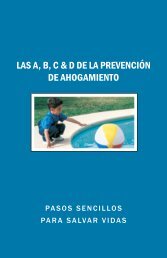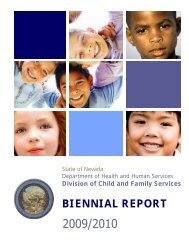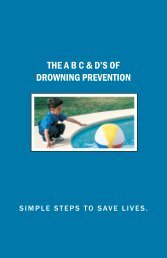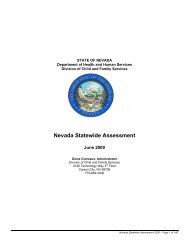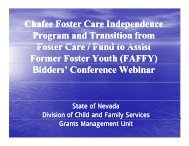STATE OF NEVADA - Division of Child and Family Services
STATE OF NEVADA - Division of Child and Family Services
STATE OF NEVADA - Division of Child and Family Services
Create successful ePaper yourself
Turn your PDF publications into a flip-book with our unique Google optimized e-Paper software.
etween st<strong>and</strong>ard <strong>of</strong> care concerns <strong>and</strong> true safety threats. This has lead workers to have more <strong>Child</strong> <strong>and</strong> <strong>Family</strong> Team<br />
meetings to discuss concerns <strong>and</strong> develop plans for addressing concerns instead <strong>of</strong> removing children unnecessarily from<br />
placement providers.<br />
Workers have also found the Visitation Safety Check helpful in being able to assess the parent’s behavior during visitation<br />
to assist them in being able to determine baseline behavior for visitations <strong>and</strong> making decisions about the appropriate<br />
level <strong>of</strong> supervision required. Workers are required to review the Visitation Safety Check with their supervisor at monthly<br />
one-to-one supervision to increase the frequency <strong>of</strong> review <strong>of</strong> the visitation plan to allow for increases in visitation or<br />
moving toward unsupervised visitation in a timelier manner.<br />
Washoe County Department <strong>of</strong> Social <strong>Services</strong>: In the past fiscal year, WCDSS was selected as a site for a<br />
Breakthrough Series Collaborative (BSC) with Casey <strong>Family</strong> Programs regarding timely permanency for reunification.<br />
Several goals <strong>and</strong> action steps were initiated with several promising results. These results include the reduction <strong>of</strong> the<br />
number <strong>of</strong> children placed into care <strong>and</strong> a greater underst<strong>and</strong>ing by all parties <strong>of</strong> the child safety model. The BSC team is<br />
very committed <strong>and</strong> engaged <strong>and</strong> is recognized <strong>of</strong>ten by Casey <strong>Family</strong> Programs staff for their work completed to date.<br />
Promising practices have been implemented <strong>and</strong> maintained. WCDSS indicates that continued implementation <strong>of</strong> the<br />
improvement model (Plan Do Study Act) once the BSC is discontinued (July 2010) will be a challenge. In addition,<br />
WCDSS reports that budget challenges are affecting caseworker caseload size, which in turn affects permanency<br />
outcomes.<br />
DCFS – Rural Region: In an effort to increase diligent search efforts the DCFS-Rural Region, through the <strong>Child</strong>ren’s<br />
Justice Act Taskforce Grant was able to purchase the LexisNexis program to conduct people searches for parents <strong>and</strong><br />
relatives. The DCFS-Rural Region also had concerns regarding the length <strong>of</strong> time children are remaining in foster care;<br />
therefore, the Supervisory Review Committee was established. Supervisors throughout the region meet monthly to<br />
review cases <strong>and</strong> the barriers to permanency for children who have been out <strong>of</strong> home care for three months or longer.<br />
Each case is reviewed on a quarterly basis. Additionally, to increase contacts between workers <strong>and</strong> children <strong>and</strong> to<br />
increase visitation between children <strong>and</strong> families, webcams have been installed on the majority <strong>of</strong> DCFS-Rural Region<br />
workers’ computers.<br />
Policy Development <strong>and</strong> Revision<br />
Statewide Policy: Over the past year two statewide policies were updated to reflect changes to legal requirements <strong>and</strong><br />
statewide casework practice. These included Policy 0101 Adoption Subsidy <strong>and</strong> 1004 Training, Assessment <strong>and</strong><br />
Licensing <strong>of</strong> Foster, Relative <strong>and</strong> Adoptive Homes. Policy 0101 Adoption Subsidy was revised to update information<br />
regarding the Fostering Connections to Success <strong>and</strong> increasing Adoptions Act <strong>of</strong> 2008(P.L 110-251). This revision was<br />
made to ensure that during the application process prospective adoptive parents <strong>of</strong> children in agency custody are<br />
informed by the child welfare agencies <strong>of</strong> the availability <strong>of</strong> a Federal Adoption Tax Credit <strong>and</strong> that they are directed to the<br />
Internal Revenue Service (IRS) <strong>and</strong>/or their tax preparer for more information.<br />
Policy 1004 Training, Assessment <strong>and</strong> Licensing <strong>of</strong> Foster, Relative <strong>and</strong> Adoptive Homes (formerly Policy 1004<br />
Structured Analysis <strong>and</strong> <strong>Family</strong> Evaluation (SAFE)) was renamed, revised <strong>and</strong> approved allowing flexibility for each child<br />
welfare agency to use their own preferred training curriculum, information gathering tools <strong>and</strong> home study template(s) to<br />
meet the needs <strong>of</strong> their children <strong>and</strong> families within their community. This revision maintains consistency in the<br />
information provided to prospective foster/adoptive parents <strong>and</strong> in the evaluative elements <strong>of</strong> home studies. Currently the<br />
DCFS Rural Region <strong>and</strong> WCDSS use the Parent Resources for Information, Development <strong>and</strong> Education (PRIDE)<br />
curriculum for training foster <strong>and</strong> adoptive parents. This curriculum uses a model for developing <strong>and</strong> supporting foster<br />
families <strong>and</strong> adoptive families, utilizing a st<strong>and</strong>ardized, consistent, structured framework for the competency-based<br />
recruitment, preparation, <strong>and</strong> selection <strong>of</strong> foster <strong>and</strong> adoptive parents, <strong>and</strong> for foster parent in-service training <strong>and</strong><br />
ongoing pr<strong>of</strong>essional development. In the fall 2009, CCDFS adopted the use <strong>of</strong> the Partnering for Safety <strong>and</strong><br />
Permanence – Model Approach to Partnerships in Parenting (PS-MAPP) curriculum for training foster <strong>and</strong> adoptive<br />
parents. This curriculum, developed by the <strong>Child</strong> Welfare Institute, trains <strong>and</strong> licenses foster <strong>and</strong> adoptive families using<br />
consultation <strong>and</strong> interaction with the participants to allow families to “self select,” as they learn about the needs <strong>of</strong> children<br />
in foster care. Information used to complete the PS-MAPP home study is collected throughout the process. Both the PS-<br />
MAPP <strong>and</strong> PRIDE curriculum provide approved families certification for both foster care <strong>and</strong> adoption which eliminates<br />
the need for a separate home study when/if a foster family chooses to adopt a child in their care, thereby expediting the<br />
process.<br />
In addition to policy development <strong>and</strong> revision, the State submitted a bill for the 2011 session to amend NRS 127.060 to<br />
allow Nevada agencies to finalize adoptions <strong>of</strong> children in their custody who are placed with families (usually relatives) in<br />
Nevada APSR – SFY 2010<br />
Page 25 <strong>of</strong> 108



